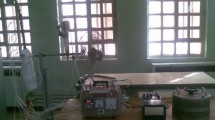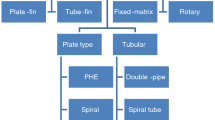Use of neural networks for calculating flow temperatures of dynamic dual-flow countercurrent heat exchanger is investigated. The optimum neural network architecture for the problem of dynamic heat exchanger modeling is chosen and the optimum numbers of neurons and layers in the network for minimizing standard error are obtained.





Similar content being viewed by others
References
N. Mohajerin and S. L. Waslander, “Multistep prediction of dynamic systems with recurrent neural networks,” IEEE Transactions on Neural Networks and Learning Systems, 30, No. 11, 3370–3383 (2019.)
C. Gan and K. Danai, “Model-based recurrent neural network for modeling nonlinear dynamic systems,” IEEE Transactions on Systems, Man, and Cybernetics, Part B (Cybernetics), 30, No. 2, 344–351 (2000).
H. G. Zimmermann and R. Neuneier, “Modeling dynamical systems by recurrent neural networks,” WIT Transactions on Information and Communication Technologies., 25, No. 7, 1381–1387 (2000).
T. R. Biyanto, M. Ramasamy, and H. Zabiri, “Modeling heat exchanger using neural networks,” International Conference on Intelligent and Advanced Systems. IEEE, 120–124 (2007).
F. P. Härter and H. F. de Campos Velho, “New approach to applying neural network in nonlinear dynamic model,” Applied Mathematical Modelling, 32, No. 12, 2621–2633 (2008).
N. A. Lavrov and S. I. Khutsieva, “Modeling of helium liquefier operation conditions,” Delovoi Zhurn. Neftegaz. RU, No. 2, 8–42 (2019).
N. A. Lavrov and S. I. Khutsieva, “Helium liquefiers: comparison of calculation methods for determination of optimum parameters,” Delovoi Dzhurn. Neftegaz. RU, No. 4, 46–48 (2017).
N. A. Lavrov, S. I. Khutsieva, and I. K. Butkevich, “Mathematical modeling of non-stationary modes of a helium liquefier,” Chemical and Petroleum Engineering, 56, I. 3-4, 302–309 (2020).
I. K. Butkevich, N. A. Lavrov, and S. I. Khutsieva, “Dynamic modeling of helium liquefier,” Future of Engineering in Russia: Collec. Papers at 12th All-Russian Conf. of Young Scientists and Specialists (with international participation) [in Russian], Moscow (2019), pp. 556–561.
N. A. Lavrov, I. K. Butkevich, and S. I. Khutsieva, “Mathematical modeling of unsteady helium liquefier operation conditions,” Refrigeration and Cryogenic Engineering, Conditioning and Life-support Systems: Paps. at 3rd Int. Sci.-Pract. Conf. [in Russian], Moscow (2020), pp. 178–179.
I. V. Tishchenko, N. A. Lavrov, and S. I. Khutsieva, “Creation of dynamic model for optimization of the temperature control loop in the air conditioning system of an aircraft,” Chemical and Petroleum Engineering, 56, I. 5–6, 412–420 (2020).
Author information
Authors and Affiliations
Corresponding author
Additional information
Translated from Khimicheskoe i Neftegazovoe Mashinostroenie, Vol. 58, No. 11, pp. 14–18, November, 2022.
Rights and permissions
Springer Nature or its licensor (e.g. a society or other partner) holds exclusive rights to this article under a publishing agreement with the author(s) or other rightsholder(s); author self-archiving of the accepted manuscript version of this article is solely governed by the terms of such publishing agreement and applicable law.
About this article
Cite this article
Lavrov, N.A., Khutsieva, S.I. & Shananin, V.A. Use of Neural Networks for Dynamic Heat Exchanger Modeling. Chem Petrol Eng 58, 917–924 (2023). https://doi.org/10.1007/s10556-023-01183-8
Published:
Issue Date:
DOI: https://doi.org/10.1007/s10556-023-01183-8




